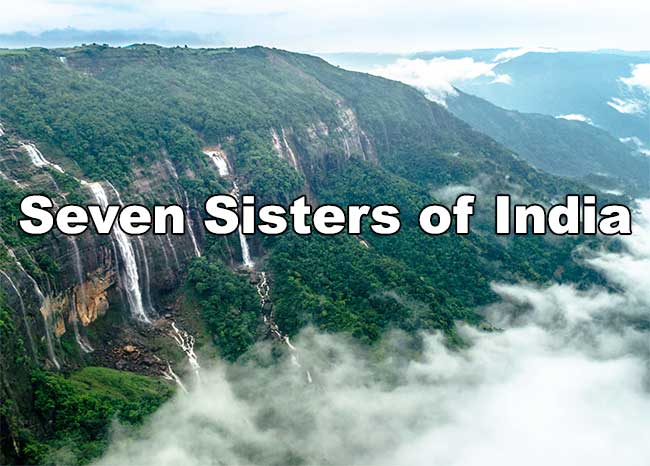
The "Seven Sisters of India" refers to the seven northeastern states of the country: Arunachal Pradesh, Assam, Manipur, Meghalaya, Mizoram, Nagaland, and Tripura. Nestled in the easternmost part of India, these states are known for their breathtaking natural beauty, unique cultural diversity, and strategic geopolitical importance. Despite being a cultural and ecological wealth treasure trove, the region also faces significant socio-political and economic challenges, shaping its complex identity.

Geographical and Cultural Diversity
The Seven Sisters are renowned for their varied geography, ranging from the snow-capped mountains of Arunachal Pradesh to the lush green hills of Meghalaya. The region is home to hundreds of ethnic groups, each with its distinct language, traditions, and way of life. This incredible cultural diversity has led to a vibrant mosaic of festivals, music, dance, and cuisine.
Assam, for example, is famous for its tea plantations and the mighty Brahmaputra River, while Nagaland is known for its tribal heritage and the annual Hornbill Festival. With its living root bridges and abundant rainfall, Meghalaya is celebrated for its natural wonders. Each state offers a unique cultural experience, contributing to the region's rich identity.
Economic and Developmental Challenges
Despite its natural resources, the Seven Sisters have struggled with economic development. The region's remoteness, poor infrastructure, and limited connectivity with the rest of India have historically hindered its growth. The region's economy is largely rural, but productivity remains low due to difficult terrain and lack of investment in modern agricultural techniques.
Industries such as oil, natural gas, and tourism hold promise, but inadequate infrastructure has been a major roadblock. The central government has taken steps to address these issues, with initiatives like the "Act East Policy" aimed at improving connectivity and fostering economic ties with Southeast Asia. However, these efforts face challenges related to local governance, insurgency, and bureaucratic hurdles.
Political and Social Unrest
The northeastern states have a long history of political unrest and insurgency, with ethnic conflicts, demands for autonomy, and separatist movements contributing to the region’s instability. Nagaland, Manipur, and Assam, in particular, have seen decades of insurgent activities, often driven by demands for greater self-determination or even complete independence from India. These movements have created an atmosphere of insecurity, which in turn has discouraged investment and hindered development.
Strategic and Geopolitical Importance
The northeastern region of India is geographically isolated, connected to the rest of the country by the narrow Siliguri Corridor, often referred to as the "Chicken’s Neck." This narrow strip of land makes the region strategically vulnerable, especially given its proximity to China, Bangladesh, Myanmar, and Bhutan. Arunachal Pradesh, in particular, has been a point of contention between India and China, with both countries laying claim to parts of the region.
The Seven Sisters also play a crucial role in India's "Act East" policy, which aims to strengthen ties with Southeast Asia. The region's location at South and Southeast Asia's crossroads makes it an important trade and transit point. Improving infrastructure and connectivity in the area is vital for boosting India's trade and diplomatic relations with its eastern neighbors.
Recent Developmental Initiatives
In recent years, both the Indian government and local administrations have made concerted efforts to boost the region’s development. Infrastructure projects such as new highways, rail links, and airports are being prioritized to improve connectivity. Additionally, programs aimed at promoting tourism, education, and healthcare are being implemented to enhance the quality of life for the region's residents.
The development of the tourism sector, in particular, holds great potential. With its stunning landscapes, biodiversity, and rich cultural heritage, the Seven Sisters could become a major destination for eco-tourism, adventure, and cultural tourism. However, these initiatives will require sustained effort, investment, and a stable political environment to succeed.
Conclusion: A Region of Opportunity and Challenges
The Seven Sisters of India represent a region of extraordinary beauty, cultural richness, and strategic significance. However, they also face a unique set of challenges, including political instability, economic underdevelopment, and social tensions. For the region to realize its full potential, it will require both internal reforms and continued support from the central government. If these challenges can be addressed, the Seven Sisters have the potential to become a vibrant, prosperous, and peaceful region, contributing significantly to India's growth and development.
#Seven_Sisters_of_India #Cultural_Diversity #Political_Unrest





